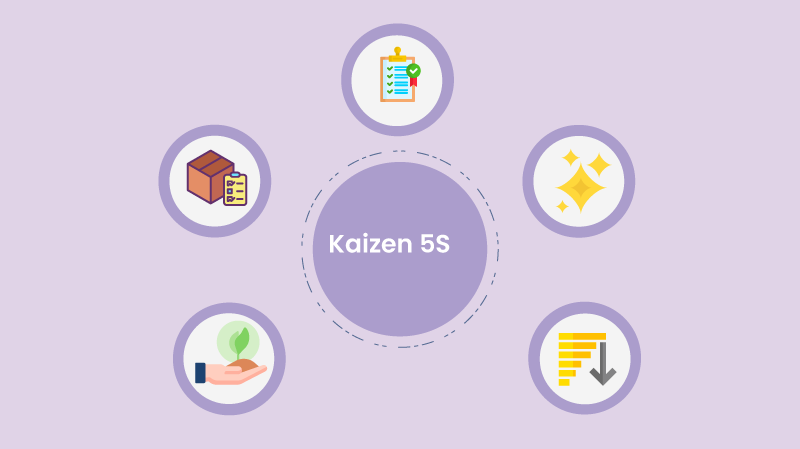Why Kaizen 5S Matters In Your Workplace?
Before we talk about Kaizen 5S, let's break the term into Kaizen and 5S to understand it better. Kaizen, which means "continuous improvement," focuses on human resources and procedures to ensure an industry's long-term sustainability. Kaizen is a Japanese term invented in the aftermath of World War II to describe how companies dealt with the war's consequences.
In Japanese, "Kai" means "change" and "Zen" means "good." (Interestingly, in Sanskrit too, Kaizen means "renew the heart and make it good.") It refers to an ongoing process of searching for new ways to enhance work processes. Thus, rather than major changes, gradual adjustments are made in this approach. Kaizen encourages everyone in the company, not just managers and executives, to search for ways to change things.
While Kaizen is a standard approach to improvement, 5S is a way to lay the foundations for progress. The two go hand in hand with 5S being an integral part of the Kaizen system. In fact, it is one of the first methods that can be used in an organization in developing a culture of quality improvement.
The Kaizen 5S system prioritizes waste reduction and standardization. 5S is an organizational framework in which everybody in the workplace helps to clear clutter and coordinate in the workspaces. A 5S implementation aids in establishing the ground rules for minimizing waste and maintaining a productive, safe, and clean workplace. It provides a stable foundation for all the present and future Kaizen operations.
Taiichi Ohno, who developed the Toyota Production System, and Shigeo Shingo, who also suggested the concept, were the first to popularise it. For companies like Toyota, Kaizen yielded tremendous results, and it has become a common production philosophy all over the world ever since.
Kaizen is a famous approach in Lean manufacturing that focuses on reducing waste while increasing efficiency in manufacturing systems. The goal of Kaizen here is to brainstorm ideas and putting them into action on a regular basis to enhance work processes. In simple words, the approach focuses on organizational quality improvement, ensuring that the workers get enthusiastic and look for ways to strengthen their work standards.
Although it was designed for manufacturing, we can use it in a wide variety of industries. From offices with administrative environments, healthcare sector, small businesses to prominent multinational corporations, Kaizen 5S works perfectly at all levels, as it doesn't need any technological research.
Understanding Kaizen 5S With An Example
Let's understand how we can use Kaizen 5S in a general office scenario.
We often limit file deletion in our office. We are also well aware of how easily paperwork accumulates and becomes out of date, making it redundant and useless. With passing time, all of that accumulation leads to clutter, both physical and emotional, which clogs up the system.
It needs a time management technique to spare out even a few hours out of a year to sort through the clutter and get rid of what is no longer needed. In fact, for better employee productivity, you must give your workers some time to go through their desks, clean out their workspaces, and start fresh. With the logical, step-by-step guide of Kaizen 5S, everything around us gets super easy and systematic.
Kaizen also entails providing workers with the necessary preparation, materials, and supervision to help them reach higher expectations and retain their ability to meet those standards daily.
William Lareau wrote a book on Office Kaizen named 'Transforming Office Operations into a Strategic Competitive Advantage.' As per Lareau, "Office Kaizen provides the foundation for the next great, step-wise competitive advantage. Office Kaizen is an implementation path, management philosophy, leadership structure, and set of tools, all wrapped into one consistent package. If employed as an executive-level, strategic weapon across an organization, Office Kaizen will create a competitive advantage that competitors cannot match unless they do the same thing simultaneously. Few will, as most will continue to search for the "brass ring" without realizing the merry-go-round has slowed to a near stop."
"Those who do not embrace Office Kaizen will be left in the dust of those who do," he adds.
Why is Kaizen 5S Needed?
Let's first know how it works without the Kaizen 5S.
- There is no structure to the improvement process, and there are just a few standard procedures.
- Processes are modified infrequently. It doesn't consider efficacy.
- There is no improvement strategy in place; progress is haphazard.
- Goals aren't described, or they're vague and hard to quantify.
So, how Kaizen 5S will help in resolving the above challenges? Read on.
- We see a clear improvement in a continuous manner.
- The aims of the improvement process are clearly defined and observable.
- We review success regularly, and the progress process is measured.
- The process's continuity leads to new, higher targets.
- It gives workers the freedom to make choices.
- It saves the company money by reducing waste.
- You can bring your savings towards your next team-building activity!
- We get better work processes that run more smoothly and effectively.
- Promotes safety and health in the workplace.
- Overall facilities improve.
- Widespread cost-cutting with higher impact.
- A strong customer experience.
- Employee engagement and motivation have increased.
Free Resource: Decoding and Driving Employee Engagement
How It Looks With And Without Kaizen 5S At Work.
Without Kaizen 5S

source: Unsplash
With Kaizen 5S

source: Unsplash
A "Kaizen Event" is distinct from "Kaizen," despite using the same name. While Kaizen is making various minor changes with the goal of continuous improvement, a Kaizen Event is a one-time, three- to five-day accelerated process to make significant changes in a specific high-priority area that needs improvement.
5 Steps To Implement Kaizen 5S
Step 1 - Look Around
- Do people in your office have difficulty identifying records or archives, whether they're physical or digital?
- Are there any unlabeled files, drawers, or cabinets, or do they contain unmarked material challenging to identify?
- Is there any sagging or loose electrical cables at work?
- Is pointless stuff taking up precious space?
- Are there any documents in your office that haven't been used and are collecting dust?
- Is everybody completely aware of their duties and obligations and how to keep the workplace organized?
If you answered yes to any of these questions, Kaizen 5S could be just what you're looking for!
Step 2 - Break Down The Kaizen 5S Process
The name 5S refers to five Japanese words that all start with the letter S when transliterated. In English, the corresponding words begin with an S as well. These five words, in turn, denote the five steps to organizational and process excellence:
Sort: Separate the required equipment, materials, and instructions from those that are not needed. Remove anything from the work area that isn't required.
Set- It follows the quote, "A place for everything and everything in its place." Sort, arrange and store all tools, equipment, files, records, materials, and services to identify and use them efficiently. Number all storage areas, supplies, and pieces of equipment. It will create an ergonomic, organized, and uncluttered space leading to a less stressful work environment.
Read our blog on: Workplace Ergonomics: Benefits And Ways To Improve It
Shine- With the clutter removed and storage space organized, it's time to shine. Establish new cleaning standards. Employees can clean their desks every day (even twice a day). However, cleaning includes storage areas, machines, equipment, tools, and work surfaces. Remove all litter, grease, and dirt from the field. All must be clean, tidy, and positioned in their proper position. Cleanliness promotes a secure working atmosphere and demonstrates possible concerns such as machinery spills, loose pieces, missing guards, strewn documents, or products.
Standardize- All old habits can fade away until this "new standard" becomes a habit. However, before this becomes a routine, it needs to be monitored and enforced. Engage the staff to perform steps 1, 2, and 3 above regularly as a routine procedure to keep the workplace in perfect shape. Develop plans and goals for follow-through.
Sustain- This final stage is always the most difficult. All of the money and effort put into developing the new system would be pointless if you cannot sustain it. The goal here is to stick to the new rules. Make Kaizen 5S a part of the company's culture by integrating it into the ideology. Create an organizational dedication to 5S such that it becomes one of the values and everyone adopts it as a habit. We should integrate the 5S approach into the performance management scheme.
The Sustain process of Kaizen 5S frequently necessitates training and effective communication, but it ultimately leads to employees becoming familiar with 5S procedures.
Step 3 - Time For Action
You will begin implementing Kaizen 5S by offering training to your workers to be familiar with the framework. It requires some one-day sessions with an employee or team to ensure everyone is on the same page when it comes to implementation.
- Take a photo of your workplace's current state.
- Decide what we require from what is not required.
- Arrange your possessions so that everything has a place and everything has a place. In just a few seconds, you should be able to find everything.
- Clean the workspace and get rid of everything that makes it impossible to keep it clean, such as boxes on the floor that prohibit you from cleaning the entire surface; instead, mark them and place them in labeled drawers.
- Create an action plan for the things you won't be able to deal with today but will be able to deal soon.
- After the whole day's work, take a second photo for comparison.
Step 4 - As We Advance
Employees should take the third photo and compare it to the first two images during the second one-day session two weeks later. Many organizations use peer audits to ensure that the Kaizen 5S values are suitably implemented and practiced. Organize cleaning schedules, describe roles and duties, and create written procedures or diagrams to help everyone know what to do.
Step 5 - Look Back
Check back on the office two months later at the third one-day session and schedule another peer review. This way, you can uphold the 5S and ensure that established schedules are adhered to and that everyone follows procedures.
Despite its simplicity, the Kaizen 5S method poses challenges in implementing and maintaining the measures. 5S can not only help workers become less stressed and more productive, but it can also increase workplace safety and reduce new employee training time.


















